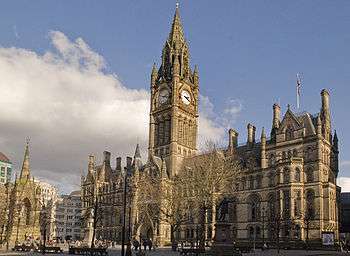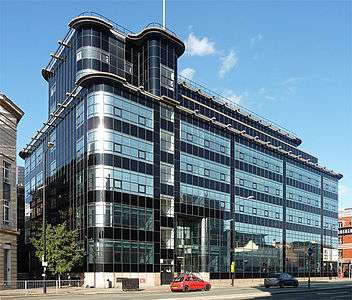Theatre Royal, Manchester
|
Theatre Royal front façade | |
| Address |
Manchester England |
|---|---|
| Coordinates | 53°28′40″N 2°14′47″W / 53.4777°N 2.2465°W |
| Owner | Edwardian London |
| Designation | Grade II |
| Type | Victorian variety theatre |
| Construction | |
| Opened | 1845 |
| Reopened | 1875, 1921, 1963, 1972, 1990 |
| Years active | 1845–1921 (as a theatre) |
| Architect |
|
The Theatre Royal in Manchester, England, opened in 1845. Situated next to the Free Trade Hall, it is the oldest surviving theatre in Manchester.[1][2] It was commissioned by Mancunian businessman John Knowles who wanted a theatre venue in the city.
The Theatre Royal operated as a theatre from 1845 until 1921, when it closed in the face of growing competition from the Palace Theatre and Opera House. The building has since been converted numerous times for use as a cinema, bingo hall and nightclub. As of 2012 it is unoccupied.
History
Manchester appears to have two previous Theatre Royals before the current building was constructed in 1845. The first opened in Spring Gardens on 5 June 1775 and operated on that site until the expiration of the proprietors' lease in 1807.[3]
The second Theatre Royal opened in Fountain Street on 12 July 1807 and was destroyed by fire on 7 March 1844.[3] John Knowles took over the management of this second Theatre Royal some time before the fire, at a time when the theatre in Manchester was at its lowest ebb.[4] Knowles set up a strong stock company and proved himself a very capable, though somewhat authoritarian, theatre manager. However, following the 1844 fire the proprietors of the theatre in Fountain Street refused to rebuild it.
At a public dinner in his honour in July 1844, Knowles was presented a plate "in acknowledgement of his energetic and successful efforts to revive national drama in Manchester".[5] Knowles told the gathering that if they could get no one else to build a theatre then he would do it himself. As a result, Knowles bought the patent rights and set about finding a site for the new theatre.[6] Knowles had always been an admirer of theatrical performances and he was anxious to see their renovation in this, his native town. He desired to see the revival of the legitimate drama, and the plays represented in a manner duly worthy of them.[5]
_Theatre_Royal_and_(Former)_Free_Trade_Hall%2C_Manchester.jpg)
Knowles found a new site for his theatre on Peter Street. He demolished the Wellington Inn and Brogden's Horse Bazaar.[7] Knowles employed Francis Chester and John Gould Irwin as the architects for his new theatre.[8] In preparation for the building of the new Theatre Royal, Knowles and Chester went to London and visited most of the metropolitan theatres, noting their areas, internal forms, acoustic capabilities, etc.[9] With a cost of £23,000, the new Theatre Royal opened to an audience of 2,500.[10] Precautionary measures against fire were taken by placing a tank on the roof capable of holding 20,000 gallons of water, which was connected by pipes to the stage and the green room. Its programme that night included Weber's Oberon overture, Douglas Jerrold's "Time works wonders" and an elaborate ballet spectacle "The Court Ball in 1740". Knowles's schedule of productions was intensive – in one season there were 157 performances at which two and sometimes three plays were performed. The popularity of the theatre grew. Charles Dickens, John Leech and George Cruickshank[7] were amongst notable people who appeared at the theatre. The theatre was dedicated to Shakespeare and Knowles installed a Carrara marble statue of the playwright above the entrance. It was Manchester's finest outdoor statue.[8] In 1875, after years of success, Knowles severed his connections with the theatre, disposing of it to a limited company for £50,000.[10]
In 1972 the theatre became a bingo hall, then a disco hall following the addition of various lighting bridges and rigs. The 1845 exterior façade is virtually intact, and the building retains the balcony from 1875.
Architecture
The theatre, which stands on an island site on the south side of Peter Street, is constructed in sandstone ashlar. It is in two storeys, with an attic, and is in Neoclassical style. Around the building, between the upper storey and the attic, is a modillioned cornice.[11] Its entrance front facing Peter Street is symmetrical with three bays, the central bay being wider than the lateral bays. The central bay is in the form of a portico, with Corinthian columns and pilasters. Its entablature contains a central semicircular arch breaking through to the gable. Steps lead up to entrances in each bay. Above the central entrance is a pedimented niche containing a statue of William Shakespeare, which is based on the statue by Peter Scheemakers in Westminster Abbey. The lateral bays contain windows with balconies in the upper storey.[12] Along the sides of the theatre are alternating rectangular windows and panels, with a blank semicircular arch above each window. The interior of the theatre has been altered, but retains its 1875 gallery. The theatre was designated as a Grade II listed building on 3 October 1974.[11] The authors of the Buildings of England series describe it as a "splendid classical composition in stone, one of the best examples of theatre architecture surviving anywhere in England from the first half of the 19th century".[12]
Present status
As of 2012 the theatre is unoccupied, although in the years since its closure there have been many proposals to bring the building back into use. The Theatres Trust has said that the internal conversions for its past usage in various guises appear to have obscured – rather than destroyed – the Trust classify the original interior work as "restorable as a theatre".[1]
In 2008, a 28-storey commercial tower was proposed which would be connected to the back of the original theatre.[13] It was announced in 2011 by owners Benmore that the Theatre Royal would receive a £2 million refurbishment to convert the building into a live music venue.[2]
Despite the promise of investment, Benmore sold the building in November 2012 to Edwardian London - owners of the Radisson Edwardian hotel adjacent to the theatre in the Free Trade Hall.[14] The building could potentially be restored as a theatre or banqueting hall as a complimentary extension for the hotel.[15]
References
Notes
- 1 2 "Theatre Royal (Manchester)". Theatre Trust. Retrieved 20 September 2012.
- 1 2 "Theatre Royal to become live music venue – with £2m refurb". Manchester Evening News. 3 November 2011. Retrieved 20 September 2012.
- 1 2 Collectanea relating to Manchester and its neighbourhood, at various periods, 2, Chetham Society, 1867, p. 59
- ↑ 'Index to the report from the Select Committee on Theatrical Licenses and Regulations', 1866, House of Commons Parliamentary Papers, vol. XVI.1, p. 217.
- 1 2 'Dinner to John Knowles, Jun, Esq', The Manchester Guardian, 17 July 1844, p. 5
- ↑ Manchester Central Library 1979, p. 18.
- 1 2 Parkinson-Bailey 2000, p. 87.
- 1 2 Rudyard & Wyke 1994, p. 57.
- ↑ 'The New Theatre Royal, Peter-Street', The Manchester Guardian, 2 October 1844, p. 5
- 1 2 Manchester Central Library 1979, p. 19.
- 1 2 Historic England, "Royale Club, Manchester (1246667)", National Heritage List for England, retrieved 26 September 2010
- 1 2 Hartwell, Hyde & Pevsner 2004, p. 322.
- ↑ "Theatre Royal Tower". skyscrapernews.com. 15 May 2008. Retrieved 24 September 2012.
- ↑ "Manchester Theatre Royal acquired by hotelier Edwardian Group". Manchester Evening News. 19 November 2012. Retrieved 2012-11-22.
- ↑ "Radisson Edwardian To Extend Into The Theatre Royal". Manchester Confidential. 21 November 2012. Retrieved 2012-11-22.
Bibliography
- Hartwell, Clare; Hyde, Matthew; Pevsner, Nikolaus (2004). Lancashire: Manchester and the South-East. The Buildings of England. New Haven and London: Yale University Press. ISBN 0-300-10583-5.
- Manchester Central Library (1979). Men and Women of Manchester. William Morris Press.
- Parkinson-Bailey, J. J. (2000). Manchester: An Architectural History. Manchester University Press. ISBN 978-0-7190-5606-2.
- Rudyard, Nigel; Wyke, Terry (1994). Manchester Theatres. Bibliography of North West England. ISBN 0-947969-18-7.





